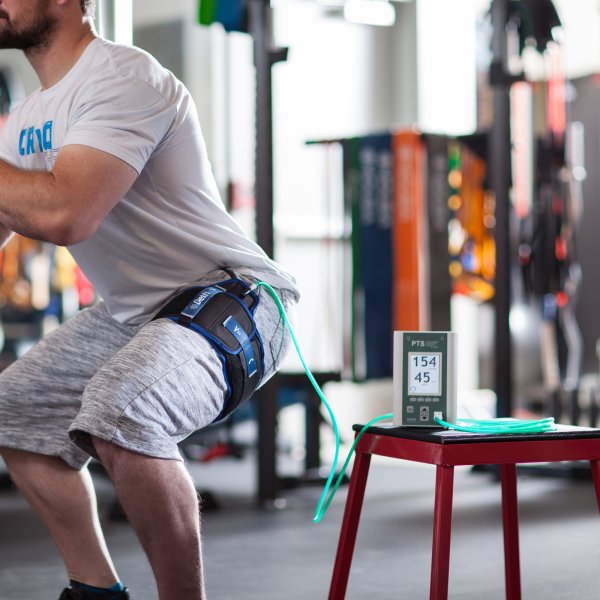If you’re like most people, you probably haven’t heard of blood flow restriction therapy until now. It’s a relatively new treatment that is starting to become more popular. So what is it? Blood flow restriction therapy, or BFR for short, is a type of training that uses low-intensity exercise with a band or cuff to restrict blood flow from the heart. This therapy has been shown to be an effective way to improve strength, size, and endurance. In this blog post, we will discuss the benefits of BFR and the things you need to know before trying it!
Contents
What Is Blood Flow Restriction Therapy?
 Blood flow restriction therapy (BFRT) is a type of physical therapy that involves restricting blood flow to an injured or weakened area. The aim of BFRT is to improve the healing process and reduce recovery time. There are a number of ways in which blood flow can be restricted, but the most common method is to use a tourniquet.
Blood flow restriction therapy (BFRT) is a type of physical therapy that involves restricting blood flow to an injured or weakened area. The aim of BFRT is to improve the healing process and reduce recovery time. There are a number of ways in which blood flow can be restricted, but the most common method is to use a tourniquet.
BFRT is often used to treat sports injuries, but it can also be used to treat other conditions such as osteoarthritis. It is thought that BFRT works by increasing the amount of growth hormone released by the body, which helps to promote healing.
A number of studies have shown that BFRT is effective at reducing pain and improving function in people with various conditions. However, more research is needed to confirm these benefits.
If you are considering BFRT for your condition, it is important to speak to a doctor or physical therapist who is experienced in this type of therapy.
How Does It Work?
While it may sound like a complicated medical procedure, blood flow restriction therapy is actually a fairly simple concept. The idea behind it is to use a tourniquet-like device to restrict the flow of blood in the limb that is being worked on. This will cause the muscles in that limb to work harder, even though they are not lifting heavy weights.
The theory is that this will lead to more muscle growth, as the muscles are being forced to work harder than they would if there was no restriction on blood flow. There have been studies conducted that seem to support this theory, and it is becoming an increasingly popular method of training, particularly for those who are looking to avoid injury.
Blood flow restriction therapy works with both upper and lower body limbs. For the upper body, a common device that is used is called a BFRB (blood flow restriction band). This is simply a band that goes around the limb and can be tightened to the desired level of restrictions.
There are also devices that can be used for the lower body, such as special wraps or belts. These work in the same way, by restricting blood flow and forcing the muscles to work harder.
So if you are interested in trying out this method of training, it is important to consult with a qualified professional before starting. This is because they will be able to assess your fitness level and ensure that you are not putting yourself at risk of injury.
What techniques Are Used In blood Flow Restriction Therapy?
 Techniques are what make blood flow restriction therapy (BFRT) effective. BFRT can use any number of techniques to restrict blood flow, but the goal is always the same: to reduce venous return while preserving arterial inflow.
Techniques are what make blood flow restriction therapy (BFRT) effective. BFRT can use any number of techniques to restrict blood flow, but the goal is always the same: to reduce venous return while preserving arterial inflow.
One common technique is wrapping a tourniquet around the limb being treated. The tourniquet is inflated to a predetermined pressure, typically between 50 and 80 percent of the patient’s systolic blood pressure. The result is reduced venous return without affecting arterial inflow.
Another common technique is using special devices that apply pressure to the limb being treated. These devices have a cuff that goes around the limb and an inflatable bladder that applies pressure to the limb. The cuff is inflated to the same pressure as a tourniquet (between 50 and 80 percent of the patient’s systolic blood pressure) and the result is again reduced venous return without affecting arterial inflow.
Still, another technique that can be used is occlusive dressings. These are applied directly to the skin and work by physically blocking blood flow. The pressure is not as well controlled with this technique, but it can be effective nonetheless.
Hence, you can see the different techniques that can be used in blood flow restriction therapy. The main aim of this therapy is to reduce venous return while preserving the arterial inflow. This will help in improving the blood circulation in the body and also helps in reducing pain and inflammation.
What Conditions It Can Help With?
Generally, blood flow restriction therapy is used to help with two main types of conditions:
Muscular conditions
Therapy can help improve the condition of your muscles. It does this by increasing the amount of blood that flows to your muscles, which helps to improve their function and performance. Muscular conditions are often described as being “weak” or “sore.” Some common conditions are:
- Achilles tendonitis
- Calf strains
- Elbow tendinitis
- Hamstring strains
- Lateral epicondylitis (tennis elbow)
- Patellar tendinitis (jumper’s knee)
- Plantar fasciitis (heel pain)
- Rotator cuff tears
- Tennis elbow
Bone conditions
 These are common among elderly patients and can take different forms. The two main types are osteoporosis (brittle bones due to loss of bone density) and Paget’s disease (enlargement and deformation of the bones).
These are common among elderly patients and can take different forms. The two main types are osteoporosis (brittle bones due to loss of bone density) and Paget’s disease (enlargement and deformation of the bones).
The goal of blood flow restriction therapy is to improve the condition of the bones by increasing blood flow and nutrients to the area. This is accomplished by using a tourniquet to restrict blood flow to the extremities, which forces the body to redirect blood flow to the bone tissue.
There is some evidence that blood flow restriction therapy can improve bone density and reduce the risk of fractures, but more research is needed.
Cardiovascular conditions
Blood flow restriction therapy has also been studied for its potential to improve cardiovascular health. One study found that blood flow restriction therapy was effective in reducing blood pressure and improving blood vessel function in patients with hypertension (high blood pressure). Some common conditions might include:
- Atherosclerosis
- Hypertension
- Coronary artery disease
- Peripheral arterial disease
Overall, these are just a few things to know about blood flow restriction therapy. As always, be sure to talk with your doctor before starting any new treatment. These conditions can be possible to manage with the help of a doctor, but always be sure to consult with them first.
What Are Some Benefits Of This Therapy?
If you are considering this type of therapy, it is important for you to be aware of the potential benefits. Some of the benefits that have been reported by patients who have undergone this type of therapy include:
- Improved circulation: This is due to the fact that the therapy helps to increase the production of nitric oxide, which is a vasodilator.
- Reduced risk of deep vein thrombosis: This is because the therapy helps to improve blood flow and prevent stagnation.
- Fewer side effects from cancer treatments: It might be possible for you to undergo chemotherapy or radiation therapy with fewer side effects if you receive this type of therapy first.
- Reduced pain: This is because the therapy can help to reduce inflammation.
- Improved range of motion: This is due to the fact that the therapy can help to reduce stiffness and improve joint function.
These benefits might be especially helpful if you are recovering from an injury or surgery. In addition, this type of therapy might be helpful if you have a chronic condition such as arthritis.
However, it is important to keep in mind that this type of therapy is not a cure-all. It is important to discuss your expectations with your doctor before you undergo this type of therapy.
What Are Some Drawbacks?
 As with many things, there are some potential drawbacks associated with blood flow restriction therapy. Some of these are listed below:
As with many things, there are some potential drawbacks associated with blood flow restriction therapy. Some of these are listed below:
There is a small risk of injury when using blood flow restriction therapy. This is because the process involves constricting blood flow to the extremities. There is a possibility that the tissues in the arms or legs could be damaged as a result of this constriction.
There is also a small risk of developing blood clots when using this therapy. This is because the constriction of blood flow can cause stagnant blood to pool in the extremities. If this pooled blood clotting, it could lead to serious health complications.
Finally, some people may experience discomfort when using blood flow restriction therapy. This is because the process can cause pain and cramping in the extremities. It can also cause dizziness and lightheadedness. If you experience any of these side effects, you should stop using the therapy and consult with a medical professional.
So these are drawbacks that a person might experience when using blood flow restriction therapy. Remember, this therapy is still relatively new and more research is needed to determine its long-term safety and efficacy. If you are considering using this therapy, be sure to discuss it with your doctor first.
Are There Any Alternatives?
If a person is not a candidate for blood flow restriction therapy, then there are a few other treatment options that can be used. These include:
One such option is low-level laser therapy. This therapy uses a low level of light to stimulate the cells and promote healing. Low-level laser therapy can be used to treat a variety of conditions, including:
- Tendinitis
- Arthritis
- Muscle spasms
- Neuropathy
Another option is electrical stimulation therapy. This therapy uses electrical impulses to stimulate the muscles and promote healing. For example, a person with a spinal cord injury may benefit from electrical stimulation therapy.
A third option is ultrasound therapy. It is a type of sound wave therapy that can be used to treat various conditions. You should discuss with your doctor whether ultrasound therapy is an option for you.
Lastly, there is cryotherapy, which uses cold temperatures to reduce inflammation and pain. It is considered one of the most effective treatments for inflammatory conditions.
You should discuss with your doctor which of these treatment options is right for you. Blood flow restriction therapy is a safe and effective treatment option for many people, but it is not right for everyone.
Conclusion
In conclusion, blood flow restriction therapy can offer a number of benefits for those who are looking to improve their overall physical fitness. However, it is important to remember that this type of therapy is not without its risks and should only be used under the supervision of a qualified medical professional.
Therefore, if you are considering using blood flow restriction therapy to improve your physical fitness, be sure to speak with your doctor first to ensure that it is the right option for you.
Physical Therapy help patients recover from pain. If you’re experiencing Back pain, Shoulder pain, Knee pain, Neck pain, Elbow pain, Hip pain, or Arthritis pain, a physical therapist at MantraCare can help: Book a physiotherapy session.


